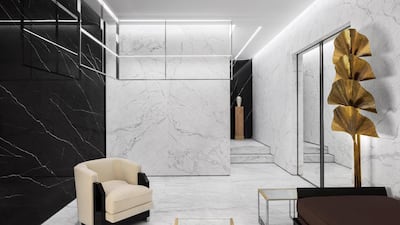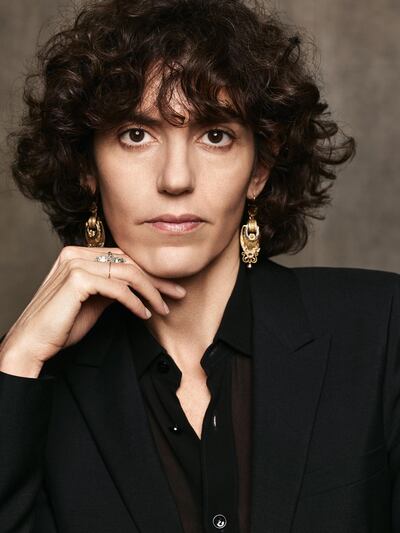Freedom, connectivity, creativity, coolness – these are the defining features of the Saint Laurent brand, says its president and chief executive Francesca Bellettini.
A fashion powerhouse with a background in banking, Bellettini is respectful of Yves Saint Laurent’s rich history – but also acutely aware that modernity and nonconformity and have always sat at the heart of this much-loved French maison. “Modernity comes from letting creativity express itself,” she maintains.
Much like the company’s founding CEO, Pierre Bergé – who was credited with nurturing and guiding designer Yves Saint Laurent’s boundless talent – Bellettini believes in crafting an environment that allows creatives to do what they do best. And then standing back and allowing them to do exactly that. “I strongly believe in generating an environment that fosters creativity as opposed to fear and oppression.”
The Italian Bellettini started her career in London, working for Goldman Sachs International, Deutsche Morgan Grenfell Group and Compass Partners International. At the age of 29, she made the move into fashion, initially joining the Prada Group and then, in 2003, Kering, the parent company of Yves Saint Laurent. She took on her current role in September 2013, and has been a formidable force in bringing the brand back to its former glory, recasting it as bold, cutting-edge, sometimes controversial – but always bitingly cool.
To coincide with the launch of a new Saint Laurent store in the Fashion Avenue extension at The Dubai Mall, we spoke to the inspired executive. In her first-ever interview with a publication in the Middle East, Bellettini tells us about the challenges facing the luxury industry, how she measures her own success and why Saint Laurent has always stood as a symbol of female empowerment.
Is it true that you took a 50 per cent pay cut when you left the banking industry? Why did you decide to make the move into fashion?
Yes, it’s true. I was 29 and I thought it was better to follow my passion – I valued my aspiration to work in the fashion industry more than money. And I was lucky to have a family that supported me in this decision. I always liked fashion; even when I was working in banking, I was dedicating myself to projects related to fashion and luxury companies. My move to fashion came thanks to Mr [Patrizio] Bertelli, the owner of Prada, with whom I worked on several projects while I was in banking and who offered me a job at Prada. And that’s where it all started.
Why did you accept the job at Saint Laurent? What was it about this brand that appealed to you?
When François-Henri Pinault offered me the position, I was strongly attracted by the extraordinary heritage of the maison and, at the same time, its present relevance and great potential for the future. I arrived at Saint Laurent in September 2013; the repositioning of the brand had already started, and I strongly believed in it. Kering decided to further invest in it and in Saint Laurent’s great potential. Not every entrepreneur would have done this, and François-Henri Pinault has been a visionary, fully supportive of the project.
The company was ready to take the challenge. When I arrived, I could immediately see the willingness of everybody in the team to make it happen. We started to focus on all the processes and organisation, aiming to build a successful future. With no compromise. We brought clarity back to the brand and built a solid business on it.
Why was Anthony Vaccarello the best person to take over as creative director of Saint Laurent? What does he bring to the brand that’s new and fresh – and to what extent has the direction of the brand shifted under his stewardship?
The creative director of any brand has to be able to express its values naturally and in an authentic way. What I could see already, by observing the work of Anthony even before I met him, was that he was going to be the one able to do this for Saint Laurent. Meeting him reinforced this idea, and made me feel secure enough to give him the creative helm of this incredible maison. And he was indeed the only person I met for the position. Now our results have proven this clearly to everybody.
Anthony Vaccarello is very determined and is not afraid of challenges. He is pushing the brand forward with clarity and modernity. Today we are in a further phase of growth, Anthony is mastering perfectly the house’s dynamics and its power over the collective imagination. He is developing an all-round vision, which is generating excellent response and results.
I strongly believe in letting creativity express itself, and in generating an environment that fosters creativity as opposed to fear and oppression. For me, this translates into letting talented creative directors express their vision in all possible ways. Anthony has his own vision and identity, and he is using his own language to take the brand to the next level, bringing it into the future while respecting its DNA. This is modernity and gives longevity. It is excellent for me to lead this inspiring maison together with such an open, modern and creative mind as Anthony, and evolve Saint Laurent together to its full potential.
What are the Saint Laurent codes? How have these evolved since you took over five years ago?
Yves Saint Laurent and Pierre Bergé created Saint Laurent Rive Gauche in reaction to the gap or differentiation between “the elites” and “the street”, between “the bourgeois” and “the people”. Yves Saint Laurent wanted to bring couture and style to the people and to open the doors of the haute couture salons to them.
Saint Laurent codes today have re-established this juxtaposition and synthesis between the street and the salons, which is at the heart of the identity of Saint Laurent. From the beginning, Saint Laurent was a rebel brand, bold and unconventional – as it is today. Both Monsieur Saint Laurent and Monsieur Bergé were not afraid to push boundaries forward, shocking, provoking. Not for the sake of it, but in the name of empowerment and freedom of thought.
The maison was actually the first to be at the same time revolutionary and luxury, and this is what we are now. These codes make Saint Laurent relevant today. Anthony is naturally embracing this spirit with a 360-degree vision for the brand, and he is bringing back the silhouette and elevated offering, still focusing on empowerment, new generation, freedom, connectivity and coolness. He is able to take references, transforming them through his vision and making them modern and relevant today, both for those who know the history of the maison, as well as for those who do not, but share our values.
Is there pressure at a historic brand such as Saint Laurent to honour the company’s history and legacy? Can this sometimes stifle progress?
Mr Yves Saint Laurent founded the eponymous maison along with Mr Bergé by putting creativity at the centre of the brand. As there was an incredible creative talent to be placed at the centre, whom Mr Pierre Bergé believed in. Each of them had his own clear role and each of them was respecting the other one in that role, and they worked together, with a common vision that was built by daily practice. Creativity is fundamental in a fashion brand, and believing in it is the key to success. This incredible heritage is the DNA of the brand, and we are lucky to have the chance to bring it into our era, while maintaining its values and spirit.
What are the biggest challenges facing the luxury industry today?
Definitely, the fast evolution of technology, which has broken barriers, expanded audiences and made the luxury industry more reachable and inclusive today than it used to be. Still, luxury was and still is about creating desire, a dream to which people aspire and with which they want to engage.
A challenge today is to take the opportunity that technology offers, but remain consistent with who we are. Which means to be consistent in all different dimensions and touchpoints with the end consumer, to connect with them in an authentic way. In order to do this, we need to hire and retain the best talent, so in the end the challenge is and remains this one.
You have said that it is important to out-behave the market. What do you mean by this?
Out-behaving means behaving better than others, as opposed to simply outperforming others. It means focusing on relationships and engagement, as opposed to simply economic performances. We are trying to achieve our economic goals without compromising on behaviour. We focus on building authentic relationships, as opposed to short-term opportunistic ones, and we do not compromise on the positioning of the brand.
Would you like to see more female executives at the highest levels of the fashion industry?
For me, it is more a matter of competence than gender. I would always like to see competent professionals in the right positions, no matter what their gender is. This fosters personal growth for everybody and enriches everybody. Concerning my own personal experience, I never felt discriminated against because I was a woman, and I always felt that [I was given] the same possibilities as men. I was born in a world where women have a lot of opportunities and I work for a group, Kering, that looks at gender equality as one of its most important values and has made it a mission.
At the same time, I recognise that not all women have been and can be as lucky as I have been, and I feel a responsibility to make sure that equal opportunities are given to [both] genders and fairness is guaranteed. The maison has always stood – maybe more than any other fashion house – for the empowerment of women and gender equality, and against gender stereotypes.
Empowerment means, above all, the freedom to express. We have always expressed this value with creative freedom, notwithstanding the risk of shocking, displeasing or being misunderstood by some. Saint Laurent empowers women and their freedom to express their conscious femininity. It is part of the house’s DNA and always will be.
What is the most important lesson that you have learnt since joining Saint Laurent?
At Saint Laurent, I learnt the importance of not being afraid to take risks when you know they are right for the brand, and how important it is to project the brand identity into the future without compromising on its value and positioning.
How do you measure your own success and how do you de-stress?
The company's success is what makes me proud, and it is the success of all the people that have worked together with me to make this happen. It is never one person, job or merit, and I strongly believe in this. Success needs the passion and participation of a whole team that believes in a common vision and wants to make it happen. To de-stress, I play sport. In particular, I love running and I do it regularly. It is very good for me also to fight jet lag when I travel.
_______________
Read more:
In attendance at the Saut Hermès showjumping competition
Montblanc pen pays tribute to The Little Prince
Head of Tod's on limited editions, safeguarding Italian history and the UAE
_______________



